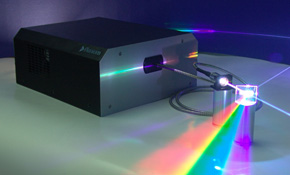
The company, JP Imaging (JPI), claims to have developed a method of laser exposure on uncoated standard grained and anodised aluminium that will switch it from its normal (oxidised) hydrophobic state to a hydrophilic state.
JPI founders Dr Rod Potts and Dr Peter Bennett, former R&D directors for lithographic printing plates at Agfa and Kodak respectively, have developed the technology in collaboration with Liverpool University with partial funding from the UK government.
The breakthrough centres around the use of an ultra-fast laser, which pulses once every 10-14 seconds (100 trillion times a second) to switch the ink receptivity of uncoated grained and anodised aluminium.
The laser causes the aluminium surface to temporarily hydrophilise, meaning the plate will perform in the same manner on a press as any other digitally-exposed plate, with the imaged areas taking fount and the non-imaged areas taking ink.
Former DuPont plate manufacturing manager John Adamson, who co-founded JPI with Potts and Bennett, claimed that the new technology had “massive environmental implications” for the printing industry.
JPI’s so called “miracle plate” could offer environmental savings on coating chemicals, coating solvents, and energy consumption during plate manufacture and subsequent use.
Adamson said: “This is the biggest breakthrough in CtP since thermal. JPI has the former R&D directors of both Kodak and Agfa. They have combined their formidable technical expertise to create the Holy Grail – CtP plates that don’t need coatings. Who needs switchable coating polymers when you can have switchable aluminium? The implications for the industry are phenomenal.”
In addition, the elimination of plate-coating means that the plate can be re-imaged using the same process once the ink has been removed and the plate returned to its normal hydrophobic state by allowing to stand for several days or by heating for a few minutes in an oven.
According to JPI, the technology will allow blank aluminium plates to be re-imaged multiple times. The company has demonstrated re-imaging and re-printing a plate up to five times in a lab.
Adamson added: “The unique feature of this technology is the use of ultra-fast pulsed lasers. This opens up a whole new field of science to us and is so novel that we have patented the technology. Normal CtP technology uses totally different lasers and needs chemical coatings on the digital plates. We don’t. We think this technology will revolutionise CtP and reduce the environmental demands of the printing industry.”
JPI said that it hoped to bring the technology to market “within two years”.
Read the original article at www.printweek.com.
Comment below to have your say on this story.
If you have a news story or tip-off, get in touch at editorial@sprinter.com.au.
Sign up to the Sprinter newsletter
